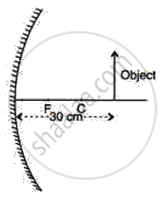Advertisements
Advertisements
Question
What is a mirror formula?
Solution
Mirror formula is the relation between the focal length f of the mirror, the distance u of the object from the pole of the mirror, and the distance v of the image from the pole.
Mirror formula is
1/v +1/u = 1/f.
APPEARS IN
RELATED QUESTIONS
A student used a device (X) to obtain/focus the image of a well illuminated distant building on a screen (S) as shown below in the diagram. Select the correct statement about the device (X).

Define the following term in the context of spherical mirrors:- Pole
Match the items given in Column I with one or more items of Column II.
| Column I | Column II | ||
| (a) | A plane mirror | (i) | Used as a magnifying glass. |
| (b) | A convex mirror | (ii) | Can form image of objects spread over a large area. |
| (c) | A convex lens | (iii) | Used by dentists to see enlarged image of teeth. |
| (d) | A concave mirror | (iv) | The image is always inverted and magnified. |
| (e) | A concave lens | (v) | The image is erect and of the same size as the object. |
| (vi) | The image is erect and smaller in size than the object. |
The diverging lens in part (a) is replaced by a converging lens also of focal length 100 mm. The object remains in the same position and an image is formed by the converging lens. Compare two properties of this image with those of the image formed by the diverging lens in part (a).
The erect image formed by a concave mirror is of size double the size of object. How are u and v related?
An object 10 cm high is placed at a distance of 20 cm in front of a spherical mirror of focal length 25 cm. By scale drawing find the nature, position, and magnification of the image in the following case:
Convex mirror
An object is placed in front of a concave mirror as shown in the following figure. By scale drawing, find the nature of the image. Given f = 10 cm, v = 30 cm.

The radius of curvature of a spherical mirror is 18 cm. What is the focal length of this mirror?
